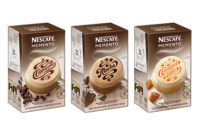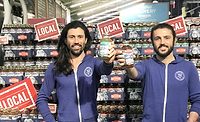According to the National Coffee Association (NCA), in 2012 the United States sustained its place as the largest coffee market in the world,

|
consuming approximately 450 million cups of coffee each day, says Nina Hughes-Likins, senior marketing manager with Synergy Flavors, Wauconda, Ill.
Within the foodservice channel, consumers are increasingly interested in stronger coffee flavors, says Angela Lantman, applications manager for coffee and tea at Synergy Flavors. Therefore, Synergy receives a lot of requests from beverage manufacturers for espresso-type flavors and dark-roasted types of flavors, she notes. However, at the retail level, consumers are interested in lighter, sweeter roasts such as Seattle-based Starbucks Coffee Co.'s Blonde roast, which has performed well in both grocery stores and Starbucks cafés, Hughes-Likins adds.
Recently, customers have begun requesting cold-brewed coffee extracts and green coffee extracts, Lantman says. Green coffee bean extract can be used to provide energy and antioxidants without the “roasted” taste of regular coffee, notes Markus Eckert, senior vice president of research and development for beverage systems and flavors with Kerry Ingredients & Flavours, Beloit, Wis.
Demonstrating this trend, Amelia Bay added a high-chlorogenic-acid liquid green coffee extract to its portfolio last year.
“Green coffee has been getting a lot of press lately due to its high chlorogenic acid content,” says John H. Crandall, vice president of sales and marketing for the John’s Creek, Ga.-based company. “It is being used in everything from weight loss products to energy drinks.”
According to media reports, green coffee’s post-meal, glucose-inhibiting properties can be important for people with diabetes and obesity issues, Amelia Bay notes. The unroasted beans also contain high levels of antioxidants or polyphenols including chlorogenic acid and caffeic acid, it adds.
“This is an ingredient that is being touted as the next ‘superfruit’-type ingredient,” Crandall says. As a result, Amelia Bay has been receiving frequent requests during the last year for its liquid green coffee extract, he says.
Other studies have shown that black coffee can reduce the risk of diseases including diabetes, Parkinson’s disease and colon cancer, says Stacy DeMars, marketing coordinator for Autocrat LLC, Lincoln, R.I. In fact, a study published in May 2012 in the New England Journal of Medicine revealed an inverse relationship between coffee consumption and mortality risk, the NCA reports. Men who drank four to five cups of coffee or more daily had a 12 percent lower risk, while women had a 16 percent lower risk, the study found.
Additionally, numerous research studies suggest that drinking coffee can reduce the risk of cardiovascular disease; lower the risk of dementia compared with non-coffee-drinkers; and reduce the risk of some cancers including liver and prostate, says John Buckner, director of marketing for S&D Coffee & Tea, Concord, N.C.
Other than coffee’s health benefits, beverage-makers often use the ingredient for its naturally occurring caffeine content, Kerry’s Eckert says. The energy drink category particularly takes advantage of this functionality as well as coffee’s flavor profile, experts say.
“Functional beverages, energy drinks and nutraceutical beverages have been growing markets and are ideal products to utilize both coffee and tea ingredients for health benefits,” Autocrat’s DeMars says. “The U.S. energy drink market is an estimated $8 billion [market] and is projected to grow nearly 12 percent annually until 2016. Therefore, the concept of using a similar application with green coffee extracts has potential growth in this market.”
DeMars adds that the global nutraceuticals market is estimated at approximately $151 billion and is projected to reach nearly $207 billion by 2016. Because of consumers’ increased interest in healthy foods and beverages, the nutraceuticals market is on track for continued growth through 2017, she says.
“The biggest change is from coffee as a breakfast wake-up beverage or an after-dinner flavored dessert beverage to an anytime indulgent snack or pick-me-up,” S&D’s Buckner says. Iced coffees and coffee frappes have become popular with teenagers and young adult demographics, he adds. As a result, the company receives the majority of its requests for natural coffee extract for producing iced coffee or coffee latte beverages, he says.
Consumers are seeking authentic coffee flavors that are well-balanced with other flavors in the beverage, Buckner explains. For instance, there should be an equal marriage of coffee and chocolate in mocha-flavored drinks, he says.
Generally, the sweet brown family of flavors, such as vanilla, nuts and chocolate, pair well with coffee flavors, Synergy Flavors' Lantman says. These flavors help to mellow the somewhat bitter taste of coffee and can help market coffee drinks to younger consumers, says Hughes-Likins, citing a September 2010 report from Chicago-based market research firm Mintel.
Following the sweetness trend, S&D’s Buckner adds that pumpkin spice, crème brulee and hazelnut flavors also are highly requested.
Coffee taste and flavor are on the bitter, sour and phenolic side of the spectrum, so sweet brown flavors (caramel, vanilla, chocolate) but also phenolic and smoky (pyrazine) flavors, such as all nut flavors, tea, smoke, barbecue, etc., work well with coffee,” Kerry’s Eckert says.



